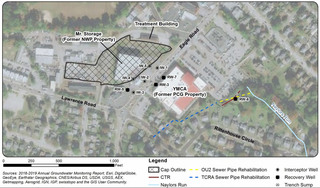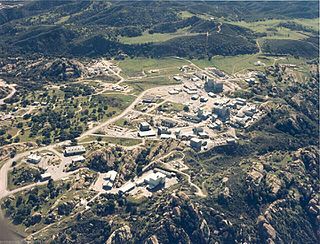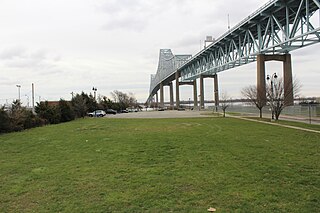
The September 11 attacks on the World Trade Center elicited a large response of local emergency and rescue personnel to assist in the evacuation of the two towers, resulting in a large loss of the same personnel when the towers collapsed. After the attacks, the media termed the World Trade Center site "Ground Zero", while rescue personnel referred to it as "the Pile".

Hazardous waste is waste that must be handled properly to avoid damaging human health or the environment. Waste can be hazardous because it is toxic, reacts violently with other chemicals, or is corrosive, among other traits. As of 2022, humanity produces 300-500 million metric tons of hazardous waste annually. Some common examples are electronics, batteries, and paints. An important aspect of managing hazardous waste is safe disposal. Hazardous waste can be stored in hazardous waste landfills, burned, or recycled into something new. Managing hazardous waste is important to achieve worldwide sustainability. Hazardous waste is regulated on national scale by national governments as well as on an international scale by the United Nations (UN) and international treaties.

Industrial waste is the waste produced by industrial activity which includes any material that is rendered useless during a manufacturing process such as that of factories, mills, and mining operations. Types of industrial waste include dirt and gravel, masonry and concrete, scrap metal, oil, solvents, chemicals, scrap lumber, even vegetable matter from restaurants. Industrial waste may be solid, semi-solid or liquid in form. It may be hazardous waste or non-hazardous waste. Industrial waste may pollute the nearby soil or adjacent water bodies, and can contaminate groundwater, lakes, streams, rivers or coastal waters. Industrial waste is often mixed into municipal waste, making accurate assessments difficult. An estimate for the US goes as high as 7.6 billion tons of industrial waste produced annually, as of 2017. Most countries have enacted legislation to deal with the problem of industrial waste, but strictness and compliance regimes vary. Enforcement is always an issue.
Marianne Lamont Horinko served as Acting Administrator of the United States Environmental Protection Agency (EPA) from July 14, 2003 to November 5, 2003 during the first term of President George W. Bush. Prior to this appointment Horinko was Assistant Administrator for the Office of Solid Waste and Emergency Response (OSWER) at EPA, having been confirmed by the U.S. Senate on October 1, 2001. She continued on as Assistant Administrator until June 1, 2004.

Superfund is a United States federal environmental remediation program established by the Comprehensive Environmental Response, Compensation, and Liability Act of 1980 (CERCLA). The program is administered by the Environmental Protection Agency (EPA). The program is designed to investigate and clean up sites contaminated with hazardous substances. Sites managed under this program are referred to as Superfund sites. Of all the sites selected for possible action under this program, 1178 remain on the National Priorities List (NPL) that makes them eligible for cleanup under the Superfund program. Sites on the NPL are considered the most highly contaminated and undergo longer-term remedial investigation and remedial action (cleanups). The state of New Jersey, the fifth smallest state in the U.S., is the location of about ten percent of the priority Superfund sites, a disproportionate amount.

The Resource Conservation and Recovery Act (RCRA), enacted in 1976, is the principal federal law in the United States governing the disposal of solid waste and hazardous waste.

In environmental law, the polluter pays principle is enacted to make the party responsible for producing pollution responsible for paying for the damage done to the natural environment. This principle has also been used to put the costs of pollution prevention on the polluter. It is regarded as a regional custom because of the strong support it has received in most Organisation for Economic Co-operation and Development (OECD) and European Union countries, and has a strong scientific basis in economics. It is a fundamental principle in US environmental law.

The National Priorities List (NPL) is the priority list of hazardous waste sites in the United States eligible for long-term remedial investigation and remedial action (cleanup) financed under the federal Superfund program. Environmental Protection Agency (EPA) regulations outline a formal process for assessing hazardous waste sites and placing them on the NPL. The NPL is intended primarily to guide EPA in determining which sites are so contaminated as to warrant further investigation and significant cleanup.
Hazardous Waste Operations and Emergency Response is a set of guidelines produced and maintained by the Occupational Safety and Health Administration which regulates hazardous waste operations and emergency services in the United States and its territories. With these guidelines, the U.S. government regulates hazardous wastes and dangerous goods from inception to disposal.
Crime scene cleanup is a term applied to cleanup of blood, bodily fluids, and other potentially infectious materials (OPIM). It is also referred to as biohazard remediation, and forensic cleanup, because crime scenes are only a portion of the situations in which biohazard cleaning is needed. Incidents which may require this type of cleanup include accidents, suicide, homicides, and decomposition after unattended death, as well as mass trauma, industrial accidents, infectious disease contamination, animal biohazard contamination or regulated waste transport, treatment, and disposal.

Havertown Superfund is a 13-acre polluted groundwater site in Havertown, Pennsylvania contaminated by the dumping of industrial waste by National Wood Preservers from 1947 to 1991. The state first became aware of the pollution in 1962 and initiated legal action against the owners in 1973 to force them to cleanup the site. The Environmental Protection Agency (EPA) ranked the site the eighth worst cleanup project in the United States. The site was added to the National Priorities List in 1983 and designated as a Superfund cleanup site in the early 1990s. Remediation and monitoring efforts are ongoing and the EPA transferred control of the site to the Pennsylvania Department of Environmental Protection in 2013.

The Energy Technology Engineering Center (ETEC), was a government-owned, contractor-operated complex of industrial facilities located within the 2,850-acre (11.5 km2) Santa Susana Field Laboratory (SSFL), Ventura County, California. The ETEC specialized in non-nuclear testing of components which were designed to transfer heat from a nuclear reactor using liquid metals instead of water or gas. The center operated from 1966 to 1998. The ETEC site has been closed and is now undergoing building removal and environmental remediation by the U.S. Department of Energy.

Wade Dump was a rubber recycling facility and illegal industrial waste storage and disposal facility in Chester, Pennsylvania. It was located at 1 Flower Street on the western bank of the Delaware River just north of the Commodore Barry Bridge.

The Office of Enforcement and Compliance Assurance (OECA) is the law enforcement arm of the United States Environmental Protection Agency (EPA). It is made up of attorneys, special agents, scientists and other employees.
The former Operating Industries Inc. Landfill is a Superfund site located in Monterey Park, California at 900 N Potrero Grande Drive. From 1948 to 1984, the landfill accepted 30 million tons of solid municipal waste and 300 million US gallons (1,100,000 m3) of liquid chemicals. Accumulating over time, the chemical waste polluted the air, leached into groundwater, and posed a fire hazard, spurring severely critical public health complaints. Recognizing OII Landfill's heavy pollution, EPA placed the financial responsibility of the dump's clean-up on the main waste-contributing companies, winning hundreds of millions of dollars in settlements for the protection of human health and the environment.
Brownfields are defined by the Environmental Protection Agency (EPA) as properties that are complicated by the potential presence of pollutants or otherwise hazardous substances. The pollutants such as heavy metals, polychlorinated biphenyls (PCB), poly- and per-fluoroalkyl substances (PFAS), and volatile organic compounds (VOCs) contaminating these sites are typically due to commercial or industrial work that was previously done on the land. This includes locations such as abandoned gas stations, laundromats, factories, and mills. By a process called land revitalization, these once polluted sites can be remediated into locations that can be utilized by the public.
Operations Plus WMD is a training level in dealing with hazardous materials.

National Response Scenario Number One is the United States federal government's planned response to a small scale nuclear attack. It is one of the National Response Scenarios developed by the United States Department of Homeland Security, considered the most likely of fifteen emergency scenarios to impact the United States. The Scenarios are related to the National Response Framework (NRF), which describes the structures and mechanisms of a response and the National Incident Management System (NIMS) that gives a framework to orchestrate emergency management. The scenario anticipates terrorists detonating a single, 10 kiloton weapon in a major city, as opposed to a full-scale nuclear war, in which a foreign power such as Russia or China would detonate hundreds or thousands of weapons.

Environmental cleanup laws govern the removal of pollution or contaminants from environmental media such as soil, sediment, surface water, or ground water. Unlike pollution control laws, cleanup laws are designed to respond after-the-fact to environmental contamination, and consequently must often define not only the necessary response actions, but also the parties who may be responsible for undertaking such actions. Regulatory requirements may include rules for emergency response, liability allocation, site assessment, remedial investigation, feasibility studies, remedial action, post-remedial monitoring, and site reuse.
Water in Arkansas is an important issue encompassing the conservation, protection, management, distribution and use of the water resource in the state. Arkansas contains a mixture of groundwater and surface water, with a variety of state and federal agencies responsible for the regulation of the water resource. In accordance with agency rules, state, and federal law, the state's water treatment facilities utilize engineering, chemistry, science and technology to treat raw water from the environment to potable water standards and distribute it through water mains to homes, farms, business and industrial customers. Following use, wastewater is collected in collection and conveyance systems, decentralized sewer systems or septic tanks and treated in accordance with regulations at publicly owned treatment works (POTWs) before being discharged to the environment.










